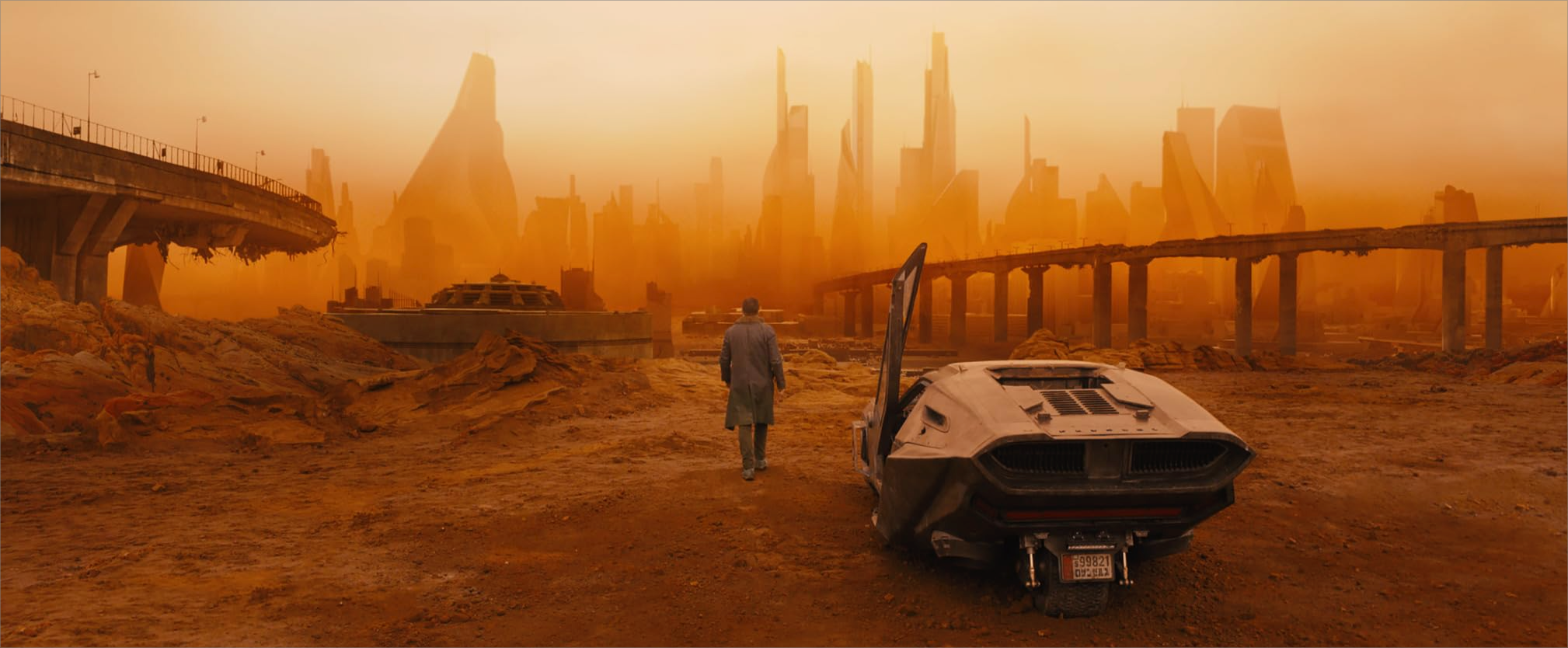This is the second in a series of pieces I am writing on dystopian movies — — broadly defined — and what they tell us, or could tell us, about our own condition and what prescriptions they might offer for a way forward. In this piece I offer a different interpretation of the two Blade Runner movies and the three commissioned shorts, arguing they can and should offer us a timely piece of advice at two of the most pressing problems of our age.
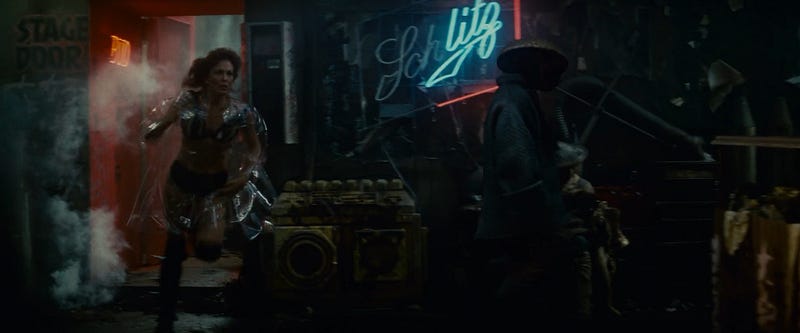
This is a review of the Blade Runner movies. But it’s really about where we are today. Although I think Blade Runner 2049, Denis Villeneuve’s 2017 sequel to Ridley Scott’s 1982 original, is deeply flawed, I believe that if we take the two movies together we can learn important lessons about our bipolar world, and where we should fit technology, in particular AI, into it.
It’s a lesson I haven’t seen others draw. And it’s based on a rather subjective view of the two movies which you might not agree with. So strap in.
(I’m assuming you’ve seen both movies, so if you haven’t, I would recommend watching them first. I’ll still be here when you get back.)
The first Blade Runner was unleashed on an unsuspecting, and somewhat unreceptive world, in June 1982 (and September in the UK). Largely ignored in the U.S. at the time, it gradually became a cult classic, casting a shadow over anyone who dared consider a sequel. Eventually Denis Villeneuve had a go, releasing Blade Runner 2049 in October 2017. Once again underwhelming at the box office (though critics mostly loved it). I’ll come out and say it: I still don’t like the second one, and am not sure I ever will. And that throws me in the trenches with those who, with very detailed and cogent arguments, also don’t like it, hurling epithets at those in the other trenches who, with equally detailed and cogent arguments, love it.
I’m not (necessarily) here to persuade you to join me in the anti-trench. But I my thesis about the two movies carrying a key, poorly understood, message for us in this particular moment in our real world narrative depends to some extent on me arguing my corner. I’ll try not to be bombastic about it. And of course, there’ll be plot spoilers in there.
Love stories
Both films are love stories, where the protagonist learns how to love. Deckard learns that it doesn’t matter whether Rachael is a replicant, or whether her memories aren’t real. She is, and that, he learns on the roof-top watching Roy Batty die amid tears and rain, is enough for him. Similarly in 2049 the protagonist K learns that while Joi, the female hologram love doll, is not real, his feelings are, his interactions with her are, and that therefore he has agency. He is capable of love, he has a soul of sorts, and he change things. His decision to help Deckard find his daughter, is that change.
Some or this interpretation, I know, is contentious, so let me briefly substantiate. In Blade Runner, when Deckard and Rachael are at the piano in his apartment, she shares her confusion about whether the memories she has are her own or not, whether her ability to play piano is from her memory or not. Deckard tells her that it doesn’t matter. “You play beautifully,” he says. She can play, therefore she is. (I’m definitely not the first to point out that Deckard is Philip K. Dick’s nod to Descartes, whose philosophy populates both book and the film.)
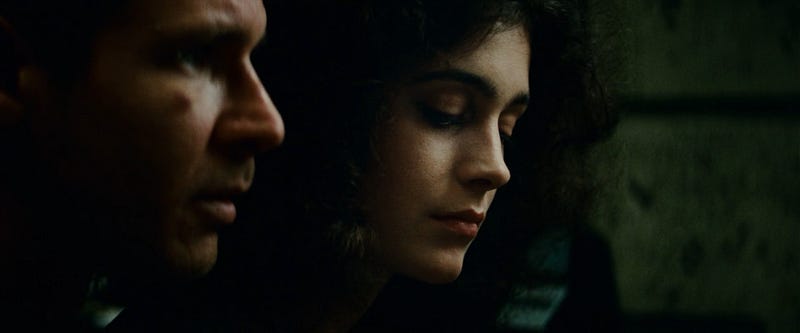
In 2049 there’s also uncertainty about K’s reaction to seeing the skyscraper-high Joi hologram, commercialism in all its brash nakedness, single him out as he walks home. When she uses the name she had given him — Joe — as a generic come-on — “You look like a good Joe” — K goes through another life-changing moment. Was their love just a clever bit of commercial programming?
The original script makes clear his thought process:
The NAME goes through K like an arrow. Joe? Jo? His mind fills with doubt and hope and doubt again. Was it all part of her program? Was she ever real?
No answers from “Joi.” Only a knowing wink and her mannequin smile as she looks back out on the city. Selling herself to the world.
CLOSE ON K. _His eyes close. As if saying goodbye. To her. To everything he learned from her to dream and hope for.
K is letting go of his memory of her as a lover, but not to the memories, the lessons she shared. For him it doesn’t matter that she was a hologram, or even an off-the-shelf virtual love doll. He learned from her. To dream. To hope. Enough for him to say goodbye, rather than, as some have interpreted the scene, discard the whole experience to trash. Like any love affair.
A constructed world
So what does all this have to do with AI?
Well, a lot of the discussion about the first Blade Runner has been about whether replicants are human, and what the differences are between the two. We are persuaded to conclude that replicants are in a way more human than human (beyond the trite motto of the company that manufactures them), because they don’t carry our baggage, they want to live, and because they have a termination date they know that time is sacred. Most of us humans are guilty of often forgetting we have a termination date too.
But this is not, in my view, the whole picture. Ridley Scott thought deeply about the movie he wanted to make, as did the author of the original script, Hampton Fancher (who also wrote the story and initial draft for the sequel), and so we should be looking deeper for richer treasures. A film well made, after all, is a constructed world that reflects our world back at us with fresh eyes.
Similarly, no-one will accuse Villeneuve of directing superficial films. Arrival (2016) is an extraordinary journey through the concept of time, and how, were time not linear, we might still decide to live our lives as we do. Sicario(2015) takes the idea of protagonist and subverts it, leaving us questioning what we believe and how we see the wall between us and the way the world really is. And don’t get me started on the Dune movies (2021, 2023).
In short, closer attention in both films is rewarded, though we shouldn’t expect, or want, the same message from both. In the first Blade Runner, Ridley understood that the message of the film was quite a tender one — as he describes it, the hunter falls in love with the hunted — but the movie needs to explain why and how that happens.
The untermenschen
It happens because humans have screwed up, and replicants are the answer to their problem. They’ve screwed up the planet, they don’t have enough people to go do the empire building off-world, and so they created an untermenschen, an underclass to do the work. It’s not the first time humans have done this, and it won’t be the last. The only difference here is that the untermenschen are artificially created humanoids.
The problem the movie presents is that the answer to the problem has itself become a problem: these replicants have rebelled and started to infiltrate Earth. The protagonist, Harrison Ford’s Deckard, is the fall-guy, the gumshoe, the Philip Marlowe who has to go do the dirty work of removing this problem. At this point in the story (2019, 37 years into the future when the first film was made) the human populace is not aware of this infiltration, and only with a sophisticated device, the Voight-Kampff test, can blade runners identify them. Even that is not infallible: In a deleted scene, one of Deckard’s colleagues, Holden, complains:
maybe it doesn’t work on these ones, Deck… These replicants aren’t just a buncha muscle miners anymore, they’re no goddamn different than you or me… It’s all over, it’s a wipe-out, they’re almost us, Deck, they’re a disease…
By the time of the second movie, released in 2017 and set 32 years hence, a lot has happened (this is all explored in three short prequels commissioned by Villeneuve, and without which a lot of 2049 is barely intelligible): three years after Deckard’s travails, gangs of humans hunt down and kill the latest generation of replicants, who have no artificial lifespan, in turn prompting a replicant terrorist attack, where an EMP causes a planet-wide blackout and erases its databases. Out of the ashes emerges another inventor-terrible, who solved world hunger and is now creating another generation of replicants. Earlier generations of replicants are still being hunted, but now their replacements are an acknowledged part of the scenery and machinery. The blade runner, replicant or not, is the middleman, policing the no-man’s land between replicant and human.
In other words, a lot has changed, but a lot hasn’t. By the time of the second movie replicants are more advanced and easier to identify (they have a serial number under their right eyeball) and live among humans, but are still treated as a subspecies. (Indeed 2049 opens with a blade runner ‘retiring’ a rogue replicant in a rehashed version of how Ridley Scott had proposed the first movie begin with, right down to the sketches.)
The canvas wall
It’s this broad canvas — two movies, three shorts — upon which the love story/detective story plays out. But of course the canvas is in many ways the story. The canvas is a world deeply divided. We see K being spat on by fellow officers, abused by his neighbours and his front door sporting welcome-home graffiti “fuck off skinner”. The only other replicants he encounters are those he’s been told to kill, prostitutes, known as doxies, or the super replicant, Luv, who works as a henchwoman for the inventor-terrible, Niander Wallace.
So we’re still stuck in a hierarchical world, where one species looks down on the other. But now they’re living cheek-by-jowl. The only thing keeping them apart is the certainty that one can side can reproduce themselves, and the other can’t. And as K’s boss Joshi puts it: “The world’s built on a wall that separates kind. Tell either side there’s no wall and you’ve bought a war, or a slaughter.”
This tension is best understood with the prequels; it does not permeate Villeneuve’s world sufficiently to convey the menace/promise upon which the movie is built, in my view. But it’s vital to the storyline because K is later forced to make a decision, just as Deckard was a generation before: whose ‘kind’ do I belong to? In other words: do I accept this definition of my world as a civil war? Do I fight, and if so, what for?
In the final scenes of Blade Runner, after Deckard watches his saviour Roy Batty die, he is confronted immediately with a choice. His police shadow, Gaff, descends in a police spinner. “You’ve done a man’s job, sir,” he shouts. Gaff, the human, is taunting Deckard that he might not be. He throws a gun at Deckard, hoping it’ll pick it up. He doesn’t. “It’s too bad she won’t live,” Gaff says. “But then again, who does?”
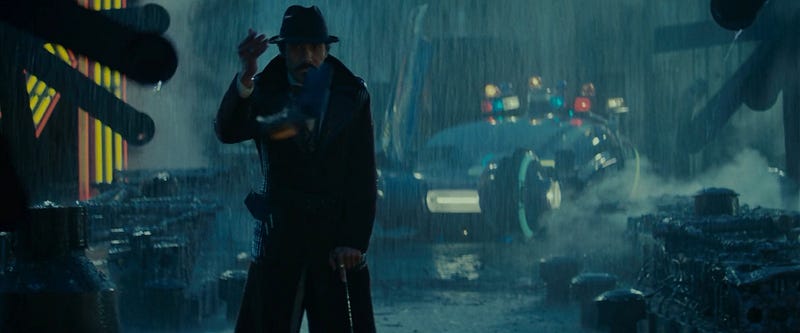
For Deckard it’s now clear what he has to do. An earlier version (23/2/81) of the script was clearer. Gaff exhibited some sadness — that Deckard had someone to love, and that love doesn’t last forever. “I wouldn’t wait too long,” he says. “I wouldn’t fool around. I’d get my little panocha and get the hell outta here.” And when Deckard’s car “bullets through the woods” as he and Rachael escape the city and outrun their pursuers, a voiceover spells out Deckard’s choice:
I knew it on the roof that night. We were brothers, Roy Batty and I! Combat models of the highest order. We had fought in wars not yet dreamed of… in vast nightmares still unnamed. We were the new people… Roy and me and Rachael! We were made for this world. It was ours!
Deckard has made his choice, chosen his side. He escapes with his lover, and the spiritual guide of his saviour Roy Batty. This bit was dropped from the shooting script, although the studio later imposed a clunky voice-over — but which, crucially, didn’t resurrect any of this talk of the world belonging to ‘us’. In any of the emerging cuts of the film Ridley Scott chose to make the story end like a love story, with the two lovers disappearing into the night. In Ridley Scott’s world Deckard had not indicated any decision to throw his lot in with the replicants.
And this is where things get confusing (spoilers ahead). The sequel chooses to build itself around the idea that Rachael and Deckard’s love story becomes the origin story of a second replicant uprising — the war that Joshi fears. Their child is proof that an earlier generation of replicant is capable of procreation. If the Deckard in 2049 was the same Deckard who believed “we were the new people” then they had in his child the rallying cry for the “wars not yet dreamed of” that would make this world “ours”.
It’s no clearer in 2049 whether this cause is what Deckard has committed himself to. Unfortunately it’s this part of the story, this narrative that sustains both films, wobbles and, I would argue, collapses in the second half of 2049. There are a number of plot holes but the key problem is not so much a plot hole as a poor solution to a major problem in the narrative. And it’s this:
All the various actors in the drama want the same thing, even if it’s not always overtly expressed: to find the replicant love child. Joshi and the police because they want to stop a war. Luv and her über-industrialist boss because he wants to reverse engineer it to build self-replicating replicants. K because his boss wants him too, but increasingly because he believes he is the love child. Deckard because he’s the father. An underground replicant army because they see an opportunity to have he/her lead an uprising.
But in 2049 this ‘race’ is half-hearted, poorly developed and incoherent. The pivot of the film is when K finds out that he is not Rachael and Deckard’s child, the growing conclusion he — and therefore we — had been coming to for much of the preceding two hours and five minutes. It is a big moment, though I’m not alone in feeling that it’s not as earth-moving as the film would like us to think it was. The problem is that this key moment overlaps with another key moment: the replicant army leader Freysa instructing K that he must kill Deckard, because he may reveal the location of his child to Luv and hence to the über-industrialist.
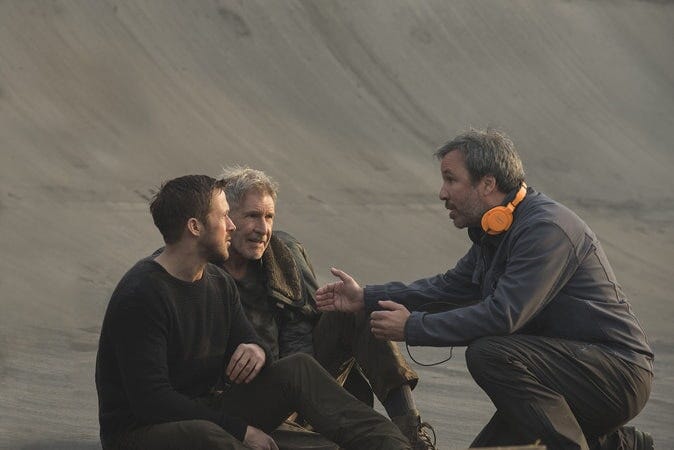
This is where the plot falls apart. And here’s why.
Somewhere before or during filming a bigger problem was fixed, leaving this rather awkward, almost hackneyed scene of combined key plot points, where suddenly a host of new characters appear, for no obvious reason and presumably at great risk to themselves.
The problem was this. In the original ‘shooting script’ — written by Fancher, the same man who wrote the first key drafts of the first movie — Freysa dismisses K’s fears that Deckard’s abduction places him in danger. “Don’t pay no mind on that. He always wanted to die for his own. Never had the luck. Officer did him a favor.” In short: Deckard identified with the replicants and wanted to die heroically for them.
She then goes on (she is written as speaking a sort of pidgin English, something that was thankfully discarded): “Deckard only want his baby stay safe. And she will. I wish I could find her… I show her unto the world. And she lead an army!” In short: Freysa doesn’t know where the replicant love child is. If she did, she would present her to the world as the leader of the replicant army — apparently with or without her say-so.
Of course a lot of this is overshadowed by the new information that floors K — namely that if the love child is female, then it’s not him. But this leaves all sorts of problems that Villeneuve needed to fix, not least of which was that it made Deckard’s fate dramatically and narratively irrelevant. He wanted to die for something so there we go. It gave very little for K to do other than accept his underwhelming fate as a normal replicant. It leaves Freysa and her army with nothing more to do except wonder where the child is — and, incidentally, not to ask K whether he had any thoughts on that, given he’d been working on this for a while and nearly died for it. And it leaves us, the audience, wondering why we had just sat through all this K-might-be-a-replicant-love-child only to find he’s, er, not.
An unfixable hole
It’s obvious why Villeneuve decided that this problem had to be fixed because it leaves K desolate and with no obvious path forward. The original script leaves only a hint that K would try to rescue Deckard (‘K can’t live with that’ when he hears Deckard would be happy dying for a cause) but there’s no real dramatic tension, no wrestling with a decision to be made about whether he rescues Deckard, kill him, do something else, or nothing. It’s a lousy pre-climax scene. And worse, it leaves only thin strand of Freysa’s motivation to go to the effort to follow K, save him and reveal to him the existence of the army and their location. If she wants him to join and help them it’s unclear why.
So something has to be done. It’s a patch-up job and not worthy of such a great film-maker, and it raises questions about how this significant problem apparently sat there all the way to the shooting script. (I would argue there are numerous other major problems that lead to this big problem, but that’s for another time.)
So the final version is this forced conflict, where K has to think about what he’s going to do with Deckard — kill him to stop him divulging the whereabouts of Freysa — or to save him (and lead him to the person he now realises is his daughter.) You don’t need to be a rocket scientist to realise it wasn’t really an either-or choice: he could save Deckard before he is forced to divulge the information and take him to meet his daughter if he’d wanted to. Which (plot spoiler) he does. Presumably, given Deckard’s stated fear that his daughter might, if identified as the replicant love child, be captured and “taken apart, dissected,” he wasn’t about to then help her lead the replicant army.
It’s probably as good an ending as Villeneuve can manage with the material. And it could be argued that the ambiguity of motivation behind K’s final act of courage and selflessness — the question that Deckard asks of him, “Why? Who am I to you?” — leaves the film as open-ended as the first film. But of course, that’s not really true. Deckard’s motive was to escape with Rachael from his human-centred world, to find something and someone better. Implicit was the idea that he had changed sides. With K, there is no such open-ended future for him, as (spoiler alert) he expires on the steps in the snow.
The only mystery then is the question he doesn’t answer: why K went to such lengths to make the reunion happen. And the possible answer, or answers, are interesting: did he realise his love for Joi was ultimately doomed and pointless, that it was better to find love in the sacrifices you make for others? A whole host of things which reflect the complexity of what makes us human.
We wrestled, along with Deckard, with similar questions when Roy Batty saves Deckard at the end of Blade Runner. This time, however, there’s no one to keep K company as he dies. Or is there? In the “shooting script” K, lying awkwardly on the steps, hears Joi’s voice asking “Would you read to me?”
Just as she said when we first met her. K smiles at this ghost of memory.
Of course.
A thready whisper of his baseline. Their old favorite. “And blood-black nothingness began to… spin… a system of cells interlinked…”
If that had been left in, it would have taken us full circle, showing us that the real love story in this film was the one between a replicant and a mass-produced hologram. In some ways that might have helped support what I believe was the thread, that Scott, Villeneuve, Fancher and the other writers wanted to be their key takeaway: that there is no wall — between replicants and humans, between replicants and holograms. There are memories, there are experiences that populate those memories, which when shared can connect every living thing.
A replicant like Roy Batty can learn to love life in the abstract, and Deckard as an embodiment of that. Rachael the replicant can learn to love and trust her own feelings. K, a replicant, can love a hologram, a supposedly lower form of AI, which in turn can learn to love, and sacrifice her/itself for love.
And the arc concludes with K choosing to himself die for love — in this case between a father who isn’t his, and a daughter who may not know she had one.
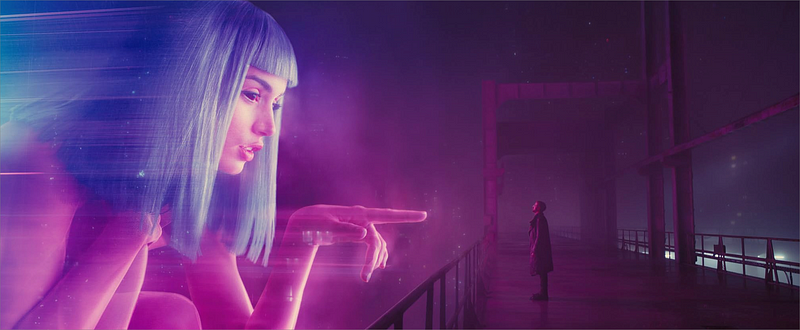
AI
So what does this have to do with AI?
Well, it’s simple enough. The villain of the piece is of course the über-industrialist, who kills replicants for fun, and exploits the feelings and loyalties of those he commands. He wants to find a replicant child to reverse engineer to expand his empire, colonise the galaxy. His megalomania sounds a lot like some of the techbro titans who bestraddle the world — and particularly those who talk of AI being both the biggest threat and the biggest opportunity humanity has faced.
Some of that hyperbole — or appetite for that hyperbole — has died down a little of late, but that doesn’t mean these ideas, ambitions are not still being pursued. All of that is taking place without any serious consideration by the rest of us, and I would argue that science fiction, dystopian fiction, in writing and film, is as good a way as any of exploring potential outcomes. Both Blade Runners conjure up a world which should be the beginning of a useful conversation.
And we shouldn’t think this is all some way off. One reviewer of the first Blade Runner said she found it all a bit far fetched, a world too noisy, dense, technofied and neon-tinted until she walked out afterwards into Leicester Square. (I had that exact same experience, and when later I lived in Bangkok, Singapore, Hong Kong and Jakarta I felt I was living in Ridley Scott’s dense, compressed, retrofitted, gridlocked world.)
But more seriously, think about the ‘replicants’ around us. Those same cities — and many others like them — are home to wall after wall after wall, keeping one kind from another. Countries like Singapore limit visas to specific workers of specific genders, and they are required to live apart from the rest of the population, often shipped around like cattle from work site to work site. Social media is full of scorn for these people who go into debt in the hope of helping their family, a silent underclass. Beyond them — in Syria, Myanmar, Sudan — are vast populations of the dispossessed, stateless, homeless. And beyond them is the animal kingdom, where we have anointed ourselves as monarch ruling over all other species. Underclasses are everywhere if we choose to look.
The genius of the first movie is that Ridley Scott gave us a compelling kaleidoscope of images, some real, some imagined, a world where our existing beliefs find themselves mutating. There is the dense streetscape of words, people, animals, street hardware (their detailed designs include a parking meter), much of which passes in a blur on a first viewing, while in Batty’s final speech we are asked to conjure up images of massive galactic battlefields and structures which are all the better for not being visualised for us. In this disorienting but all-absorbing world he asks us to question whether the difference between man and machine really exists and that feelings, emotions are rendered fluid. As Deckard says in an unused voiceover:
Replicants weren’t supposed to have feelings, neither were Blade Runners. What the hell was happening to me?
We are not good at knocking down walls. We need films like these to help us look back at ourselves and think more deeply about what those walls are and whether they should exist. From refugee to robot, we think we know where we stand in the abstract, what our values are. But it’s only when we are confronted with the reality we realise we are not so well prepared. The Blade Runner sequence gives us a glimpse of that.
And while real replicants are not yet in the shops we are already used to disembodied voices like Alexa, or GPT chats. But we haven’t even started to understand what we want from these early AIs: We expect these tools to be anthropomorphic because we are hard-wired to interact with everything — man, animal, machine — in that way. But we are far from really understanding what that means. When Claude GPT prefixes answers with — Great question!/That’s an interesting question about the Atari brand appearing in the Blade Runner films/You’ve raised an excellent point that highlights a subtle but important detail in the original Blade Runner film/You’re quite observant to notice this discrepancy (all genuine responses) I feel patronised and irritated. It may be a small thing for now, but to me this is going to be the hardest part, or one of the hardest parts, to reconcile as our AIs move from generic to increasingly personal, bespoke, bilateral nature of computer interaction.
For me the problem is this: we are already in this dangerous world where we interact with machines, without any notion of what constitutes civilised behaviour. We curse and roll our eyes at Alexa’s stupidity, but then laugh at her attempts to make friendly chit-chat. Similarly with ChatGPT we are so over the novelty of it, even though it is a hugely powerful tool, and one that I’ve been using almost as Deckard and K interacted with their machines. But we have no baseline, no manual of the appropriate etiquette. We have already established our dominance over machines, and so it’s a relatively small step for those machines to cross the uncanny valley, where we will continue to treat them as machines.
The Blade Runner stories may be driven by love, but they are really ethical journeys, preparing us for that moment, when a human creates something that approximates sentient life. Key to that discussion is what, and who, led us to that moment. What that sentient life is depends on which human, or humans, creates it, and this is, I suspect, is the root cause of our unease. Neither über-industrialist Tyrell nor Wallace is portrayed as a pleasant, civic-minded or moral individual, which perhaps tells us all we need to know of who, out here in the real world, we should be keeping an eye on.
Sources
Too many to list here, but the main ones I drew on are these. Apologies for any omissions.
- Blade Runner 2049, story by Hampton Fancher, screenplay by Hampton Fancher and Michael Green, ‘Final Shooting Script’, no date
- Blade Runner, screenplay by Hampton Fancher and David Peoples, February 23, 1981
- Blade Runner: The Inside Story, Don Shay, July 1982
- Do Androids Dream of Electric Sheep, Philip K. Dick, 1968
- Are Blade Runner’s Replicants “Human”? Descartes and Locke Have Some Thoughts, Lorraine Boissoneault 11–2017
- Deckard/Descartes, Kasper Ibsen Beck, Google Groups, 1999
- A Vision of Blindness: Blade Runner and Moral Redemption, David Macarthur, University of Sydney (2017)
- Several interviews with Hampton Fancher: Sloan Science and Film (2017), Forbes (2016), Unclean Arts (2015)
- Blade Runner Sketchbook, 1982
- Philosophy and Blade Runner, Timothy Shanahan, 2014
- The Illustrated Blade Runner, 1982
